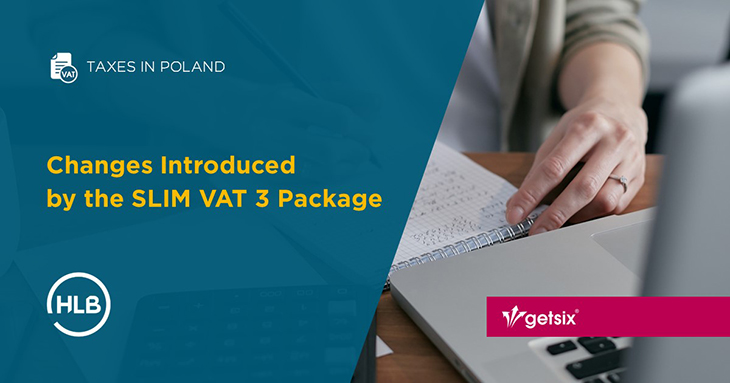Changes Introduced by the SLIM VAT 3 Package
In recent years, the Polish government has made numerous changes to the VAT tax, aiming to simplify and streamline the tax system for entrepreneurs. One of the latest packages is SLIM VAT 3, which came into effect on July 1, 2023. Below are the most important changes introduced in this package.
Small VAT taxpayer:
The sales value limit at which a taxpayer will be recognized as a small VAT taxpayer has been changed. After the introduction of Slim VAT 3, it now stands at 2,000,000 euros. A taxpayer meeting the definition of a small taxpayer can recognize the tax obligation using the cash method and benefit from quarterly settlements.
Exchange rates used in corrective invoices:
Clear rules have been introduced regarding exchange rates used for corrective invoices.
If a correction results in a change in the amount expressed in foreign currency, the rate accepted before the change (rate before correction) is used.
However, if the correction is issued due to a discount or price reduction, and the amounts on the invoice were expressed in foreign currency, one should use:
- the average NBP (National Bank of Poland) rate on the last working day before issuing the correction, or
- The European Central Bank rate on the last working day before the day of issuing the corrective invoice (for currencies other than the euro, the rate to the euro is used).
Intra-Community acquisition of goods:
Under SLIM VAT 3, regulations concerning the exchange rate for collective invoice corrections related to IC-acquisition, when a discount or reduction was granted, were introduced. In such situations, one should use:
- the average NBP rate on the last working day before issuing the correction, or
- The European Central Bank rate on the last working day before the day of issuing the corrective invoice (for currencies other than the euro, the rate to the euro is used).
Moreover, conditions for reducing the amount of tax due for IC-acquisition transactions have been simplified. Now, the right to reduce the amount of tax due by the amount of input tax in the case of IC-acquisition arises only when the taxpayer includes the amount due for IC-acquisition in the tax return in which they are required to settle this tax.
Intra-Community supply of goods – changes in corrections:
In the event of a delay in gathering evidence that the goods being the subject of IC-supply were exported from the country’s territory and delivered to a buyer in another EU country, obtaining these documents entitles the taxpayer to show IC-supply with a 0% rate for the settlement period in which the tax obligation arose from this IC-supply.
Mixed Sales:
Regulations have been changed concerning goods and services used by the taxpayer, both for activities which entitle them to reduce the amount of tax due and activities which do not.
Changes introduced by the SLIM VAT 3 package in this area state that:
- If the taxpayer had no turnover in the previous year, or its turnover was lower than 30,000 PLN, an estimated proportion is assumed, and the taxpayer only informs about the proportion they have adopted.
- It is possible to assume that the proportion is 100% when the calculated proportion was 98% and the amount of input tax not subject to deduction, resulting from the use of this proportion, annually, was less than 10,000 PLN.
- The taxpayer may not make a correction of the amount of tax if, after the end of the year, it turns out that the difference between the proportion adopted by estimation and the proportion determined for the completed tax year did not exceed two percentage points.
Correction of declarations in the OSS and IOSS procedures:
Taxpayers who used the OSS and IOSS procedures can now correct declarations, even if they are no longer in this procedure.
Expansion of the possibilities of using funds from the VAT account:
The list of possibilities to use funds from the VAT account has been expanded. After the changes, funds accumulated in the VAT account can be paid to the tax office account to settle various tax liabilities, such as:
- Tax on the extraction of certain minerals and interest on arrears in this tax,
- Retail sales tax and interest on arrears in the retail sales tax,
- Fees for foodstuffs and additional fees,
- Flat-rate tax on the value of sold production and interest on arrears in this tax,
- Tonnage tax and interest on arrears in the tonnage tax,
- Fees mentioned in Art. 92 para. 11 of the Act on Upbringing in Sobriety and Counteracting Alcoholism, an additional fee referred to in Art. 92 para. 21 of this Act, and interest on arrears from these fees (so-called fee for “miniature”).
Additionally, the transfer of funds between VAT accounts within one VAT group has been regulated.
Printing documents on a fiscal cash register:
There is no longer a need to print documents when using online cash registers. In this case, the taxpayer can decide whether to keep a paper fiscal receipt for this sale in the documentation or just the document number and the unique number of the registering cash register contained on the fiscal receipt in electronic form.
In conclusion, the SLIM VAT 3 package introduces many significant changes aimed at simplifying and improving the tax system for entrepreneurs. It’s worth familiarizing oneself with them and adapting one’s business to the new regulations. If you have questions about the new regulations, consult a tax expert.
 Source: The article was created in collaboration with our cooperation partner – JRD Tax Advisory Office
Source: The article was created in collaboration with our cooperation partner – JRD Tax Advisory Office
If you have any questions regarding this topic or if you are in need for any additional information – please do not hesitate to contact us:
CUSTOMER RELATIONSHIPS DEPARTMENT

ELŻBIETA NARON
Head of Customer Relationships
Department / Senior Manager
getsix® Group
***





